In Memoriam
In memory of Australians and New Zealanders who served their countries, ANZAC Day marks the first major military action fought in WWI …
In memory of Australians and New Zealanders who served their countries, ANZAC Day marks the first major military action fought in WWI. The poet Leon Gellert, who penned the following poignant words, was 23 when he landed on Anzac Beach in 1915.
We still remember them, 109 years later.
The Last To Leave
by Leon Gellert (1892–1977)
The guns were silent, and the silent hills
had bowed their grasses to a gentle breeze
I gazed upon the vales and on the rills,
And whispered, ‘What of these?’ and ‘What of these?’
These long forgotten dead with sunken graves,
Some crossless, with unwritten memories
Their only mourners are the moaning waves,
Their only minstrels are the singing trees
And thus I mused and sorrowed wistfully
I watched the place where they had scaled the height,
The height whereon they bled so bitterly
Throughout each day and through each blistered night
I sat there long, and listened – all things listened too
I heard the epics of a thousand trees,
A thousand waves I heard; and then I knew
The waves were very old, the trees were wise:
The dead would be remembered evermore—
The valiant dead that gazed upon the skies,
And slept in great battalions by the shore.
Words sourced from allpoetry.com
Potato Palaver
I don’t often make Croatian style potato pancakes as it is a bit of a palaver, to be honest. Last week, however, I suddenly decided I would revisit my roots and make them. Subsequently, when I was brainstorming ideas to experiment with risoprinting effects, I thought it would be fun to create a step-by-step illustrated recipe to share – so here we are.
I don’t often make Croatian style potato pancakes as it is a bit of a palaver, to be honest. That comes from this modern style of cooking dinner where you arrive home from work, throw your hands up in the air in despair and throw whatever is in the fridge into a stir-fry, or salad bowl. Last week, however, I suddenly decided I would revisit my roots and make them.
Subsequently, when I was brainstorming ideas to experiment with risoprinting effects, I thought it would be fun to create a step-by-step illustrated recipe to share – so here we are. As legibility was important, I kept the texture to a minimum under the text, and did not include any misaligned registratation effects.
When researching potato pancake recipes – according to Professor Google – I found no one else in the world seems to make them using this same method. My friend suggested it was a secret family recipe, but while that’s an exciting notion, it can’t be true, as questioned, my mum said both her own mother and my dad’s Ukrainian mother made them this way. Also, it utilises the same dough as potato dumplings, the recipe of which is commonly known.
One of my sisters says she usually only makes these when she has leftover mashed potato, and suggested that perhaps grandmas all over the countryside did so, but never passed the method on. It seems odd to me. Surely other people hailing from that part of the world have done the same? If you have or know of anyone who has, please let me know! Otherwise, feel free to try the recipe out yourself.
For the Fallen
 In commemoration of Anzac Day, here, by Robert Laurence Binyon (1869-1943), is the well-known poem For the Fallen, which was published in The Times newspaper on September 21, 1914.
In commemoration of Anzac Day, here, by Robert Laurence Binyon (1869-1943), is the well-known poem For the Fallen, which was published in The Times newspaper on September 21, 1914.
Binyon wrote the poem in mid-September, 1914, just a few weeks after the outbreak of WW1, after the British had suffered casualties in their first encounter with the German army at the Battle of Mons. He said it was the words of the famous fourth stanza that came to him first.
Between his timeless words are some photographs I took of a field of poppies in the Rif Mountains of Morocco. (It was a very windy day, and it was hard to capture the dancing poppies, so they’re a bit blurry.)
For the Fallen
With proud thanksgiving, a mother for her children,
England mourns for her dead across the sea.
Flesh of her flesh they were, spirit of her spirit,
Fallen in the cause of the free.
Solemn the drums thrill: Death august and royal
Sings sorrow up into immortal spheres.
There is music in the midst of desolation
And a glory that shines upon our tears.

They went with songs to the battle, they were young,
Straight of limb, true of eye, steady and aglow.
They were staunch to the end against odds uncounted,
They fell with their faces to the foe.
They shall grow not old, as we that are left grow old:
Age shall not weary them, nor the years condemn.
At the going down of the sun and in the morning
We will remember them.
They mingle not with their laughing comrades again;
They sit no more at familiar tables of home;
They have no lot in our labour of the day-time;
They sleep beyond England's foam.
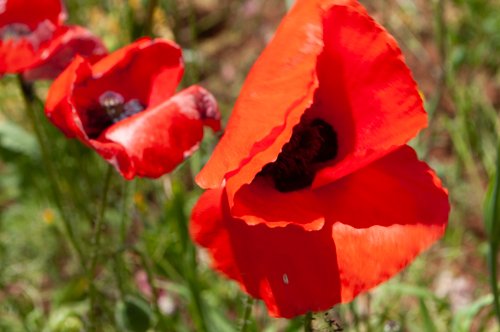 But where our desires are and our hopes profound,
But where our desires are and our hopes profound,
Felt as a well-spring that is hidden from sight,
To the innermost heart of their own land they are known
As the stars are known to the Night;
As the stars that shall be bright when we are dust,
Moving in marches upon the heavenly plain,
As the stars that are starry in the time of our darkness,
To the end, to the end, they remain.
A Sweet Easter
 I love a vintage illustration for holidays – how sweet is this little girl and dancing bunny? I’m not well-versed in vintage printing techniques, but I love the grainy texture that is visible, as well as the simple colour palette; both are probably incidental to the printing method, chromolithography, which involves applying oily inks to limestone.
I love a vintage illustration for holidays – how sweet is this little girl and dancing bunny? I’m not well-versed in vintage printing techniques, but I love the grainy texture that is visible, as well as the simple colour palette; both are probably incidental to the printing method, chromolithography, which involves applying oily inks to limestone.
I hope you have a wonderful Easter, with or without dancing bunnies (chocolate or otherwise)!
(Image from The Graphics Fairy)
Graveyard of Dreams
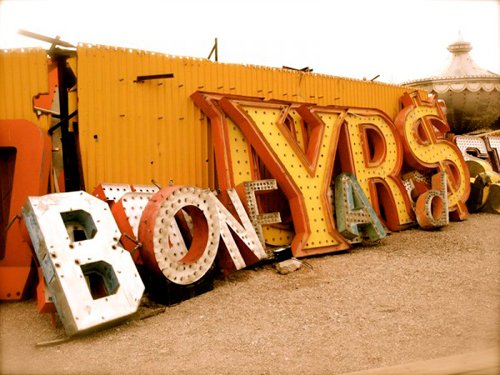 I had stumbled across images of the Neon Boneyard before online, but the other day I had to do some picture research at work on neon signs, and I was reminded once again of the fairylandish wonderland that is the Las Vegas Neon Museum.
I had stumbled across images of the Neon Boneyard before online, but the other day I had to do some picture research at work on neon signs, and I was reminded once again of the fairylandish wonderland that is the Las Vegas Neon Museum.
The Museum is located in a desert strip not far from Las Vegas, and first opened in 2012 with its first restored sign, the Hacienda Horse and Rider. Since then it has amassed over 200 signs in its Boneyard, nine of which are fully restored.
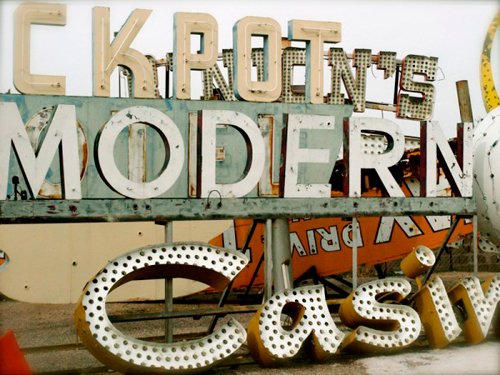 The gallery includes the Lucky Cuss Motel, the Bow & Arrow Motel, The Silver Slipper, Society Cleaners, Binion's Horseshoe, the Normandie Motel, the Hacienda horse and rider, the Landmark and 5th Street Liquors. Just the names are evocative enough to send me daydreaming of travel.
The gallery includes the Lucky Cuss Motel, the Bow & Arrow Motel, The Silver Slipper, Society Cleaners, Binion's Horseshoe, the Normandie Motel, the Hacienda horse and rider, the Landmark and 5th Street Liquors. Just the names are evocative enough to send me daydreaming of travel.
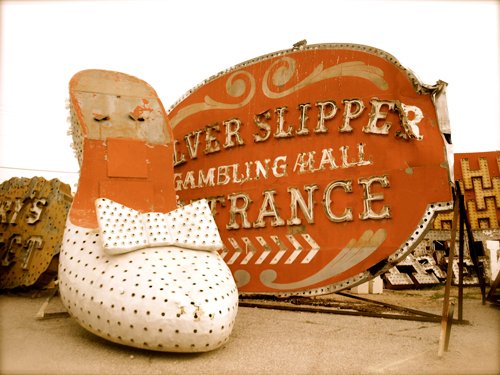
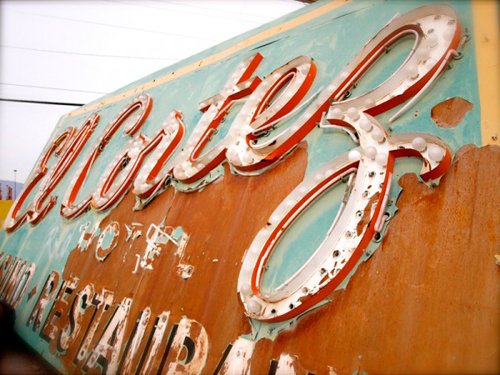 How I would love to go there! It would be glorious to wander amongst all these decayed and decrepit relics of history. One can only wander on a guided tour however, and they offer both day and night tours. During the latter, the restored signs are lit up, and the others are illuminated with dramatic lighting. I would be compelled to book both!
How I would love to go there! It would be glorious to wander amongst all these decayed and decrepit relics of history. One can only wander on a guided tour however, and they offer both day and night tours. During the latter, the restored signs are lit up, and the others are illuminated with dramatic lighting. I would be compelled to book both!
These great photos – appropriately vintage-looking – are by Pam Sattler, found on The Coolist.





